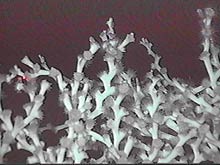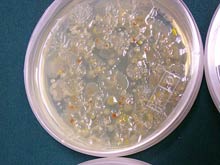
Figure 1: This shallow water Bahamian reef supports a diverse array of corals, sponges, and fish. The kaleidoscope of bright colors is what most of us envision when we think of corals. Click image for larger view and image credit.
Microbial Communities Associated with Deep-water Corals
Julie Olson
University of Alabama
When someone hears the word coral, the mental image most often created is that of a shallow water coral reef species- a greenish to brownish mounding (or branching) colonial organism that is surrounded by a vast array of brightly colored fish and sponges (Figure 1). The corals that are the focus of this expedition are quite different. As a result of the depth where they are found, no sunlight reaches the ocean floor so these corals lack photosynthetic symbionts (colorful organisms which live within the coral's tissues in a symbiotic relationship, sharing food and receiving shelter), which makes them bright white (Figure 2), and forces them to rely on other mechanisms for generating energy. Deep-water corals remove small particulate materials from the surrounding water column to use as food. In addition to having tentacles to 'grab' materials, many corals often secrete mucus (slime) layers which help to trap particles as they move by in the current.

Figure 2: This thicket of Lophelia pertusa corals from the Gulf of Mexico displays the calcium carbonate skeleton and the coral tentacles. The bright white appearance of these corals is often in stark contrast to the dark surrounding ocean floor. Click image for larger view and image credit.
Within this mucus layer live many microorganisms. Differences in the microbial communities associated with healthy and diseased host corals have been found but little is still known about the function of these microorganisms. Current theories include serving as disease pathogens, providing a source of food for the coral, transient organisms living on the carbon-rich mucus, or functioning as defensive organisms, helping the coral fend off potentially pathogenic microorganisms. By examining different host corals at various locations and depths, scientists may be able to tease apart the factors that control the composition and functions of the microbial community.
Several approaches will be used on this expedition to characterize the microorganisms collected from the coral mucus. Cultivation, or growing the associated microbes, is one method (Figure 3). Unfortunately, only about one percent of microorganisms can be cultivated under laboratory conditions, suggesting that this approach 'misses' the vast majority of the biodiversity. It is still useful, however, for providing isolates that can be studied to learn more about their metabolism and potential for providing chemical defenses for the host coral. The second approach is to use the genetic information stored in the microbes without having to grow them. The DNA (deoxyribonucleic acid) is extracted from all cells, coral and microorganism, and is subjected to amplification in the laboratory to provide sufficient material. By using short starting sequences for the amplification reaction, it is possible to only reproduce the genetic information from the organisms of interest. The resulting amplified communities can be analyzed with a variety of techniques to shed light on the diversity, specificity, and potentially the function of the associated microorganisms.

Figure 3: Microorganisms cultivated from deep-water organisms. Notice the variety of colors, shapes, and sizes of the resulting colonies. By the time the colony is large enough to be seen by the human eye, it has at least one million cells. Click image for larger view and image credit.
Because these corals are found at deep-water sites and are often associated with topographic features of the ocean floor, a submersible is necessary to obtain samples. Small pieces of the corals will be collected using the Harbor Branch Oceanographic Institution's Johnson-Sea-Link manned submersible and preserved while underwater such that the microbial community associated with the coral mucus will not be affected by the movement of the sub through the water to the surface. Replicate samples will be taken for microbial cultivation but will likely be affected by the change in ambient water, temperature, and pressure.
Using methods such as those described above will allow us to learn more about the distribution, abundance, and function of the inhabitants of the deep ocean, enabling us to add to the body of information necessary for effective resource management decisions.
























